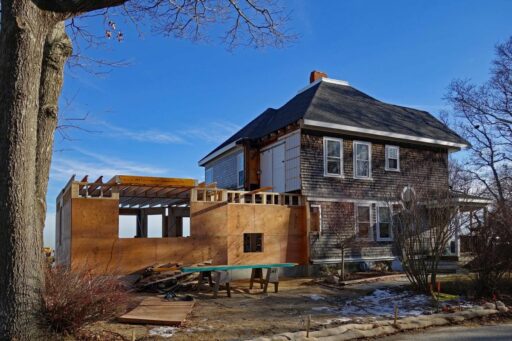In the dynamic world of home remodeling, staying informed about the latest trends and gathering expert advice is crucial for homeowners looking to revamp their living spaces. This blog provides a comprehensive overview of current remodeling practices, as shared by seasoned contractors. From evaluating credentials to post-remodel maintenance, we delve into the essential aspects of transforming your home with confidence and style.
Key Takeaways
- Verified reviews and client testimonials are invaluable for assessing a contractor’s reliability and quality of work.
- Understanding the breakdown of costs and project timelines is essential for setting realistic expectations for your remodel.
- Modern design trends and material choices can significantly influence the durability and aesthetics of your remodeled space.
- Effective planning and communication during the remodeling process are key to a successful project completion.
- Regular maintenance and understanding when to call professionals for repairs will help preserve the value of your remodeled home.
Evaluating Contractor Credentials and Client Feedback

The Importance of Verified Reviews in Selecting a Contractor
In the digital age, the significance of verified reviews cannot be overstated. Choosing the right contractor for your remodeling project is a decision that hinges on trust and reliability. Verified reviews serve as a testament to a contractor’s reputation and quality of work. They provide a transparent record of past performances, allowing homeowners to make informed decisions based on the experiences of others.
When browsing through contractor reviews, it’s essential to look for patterns that indicate a contractor’s strengths and weaknesses. Here are some key points to consider:
- Consistency in positive feedback across multiple projects
- Responsiveness to client inquiries and issues
- Detailed accounts of the contractor’s process and outcomes
It’s not just about the number of stars a contractor has, but the substance behind the ratings that truly matters.
Furthermore, platforms like Angi and Birdeye have become crucial in the remodeling industry, offering a space where contractors can be evaluated beyond mere word of mouth. These sites help businesses grow, build social proof, and become trustworthy names in the marketplace. It’s advisable for homeowners to explore these platforms and consider the insights they provide before making a final decision.
Assessing the Longevity and Consistency of a Contractor’s Work
When considering a contractor for your remodeling project, it’s crucial to assess their track record for delivering quality work that stands the test of time. Look for a history of projects that have maintained their integrity and appearance years after completion. This not only speaks to the skill of the contractor but also to the quality of materials used.
To gauge a contractor’s consistency, consider the following steps:
- Outline your acceptance criteria for the project.
- Plan out inspections at various stages.
- Create a checklist for quality control.
- Correct any deficiencies promptly.
Ensuring that a contractor meets these criteria can significantly reduce the risk of future repairs and maintenance issues.
Additionally, real client testimonials can provide valuable insights into the contractor’s reliability. For instance, feedback from clients who have engaged with the contractor over many years can highlight the contractor’s ability to deliver consistent results. It’s also beneficial to ask about the contractor’s approach to addressing any issues that may arise post-completion.
Real Client Testimonials: Insights from Recent Remodels
Hearing from homeowners who have recently undergone remodeling projects can provide invaluable insights into the quality of work and customer service provided by contractors. Client testimonials are a cornerstone for gauging real-world satisfaction and setting expectations.
Recent feedback highlights the exceptional work of contractors like Midwest Square Customs and Greg Mangini LLC, with clients praising their attention to detail and craftsmanship. For instance, Maureen D. expressed her delight with her new living room and kitchen, citing the crew’s great communication and solid work. Similarly, Gay T. has been a repeat client of Greg Mangini for over 19 years, emphasizing the consistent quality delivered by his team.
The collective voice of clients is loud and clear: a successful remodel hinges not just on the end result, but also on the journey there, including the professionalism and reliability of the contractor.
Here’s a snapshot of recent ratings and comments:
- Midwest Square Customs
- Maureen D. (February 2024): 5.0 – "Very satisfied with the overall project…"
- Haley L. (February 2024): 5.0 – "Tile Backsplash is perfect!!"
- Greg Mangini LLC
- Gay T. (January 2024): 5.0 – "Gregg is the best…master craftsman and carpenter."
- Judy L. (February 2024): 5.0 – "Excellent job!"
While online resources can be helpful, they sometimes lack depth, as seen in a Website page about Best Contractors with limited content and no specific information. It’s crucial to look beyond surface-level reviews and seek out detailed, personal accounts of contractor performance.
Understanding the Scope and Cost of Your Remodeling Project

Breaking Down the Cost: Materials and Labor Explained
Understanding the costs involved in a remodeling project is crucial for homeowners. The total expense is typically divided into two main categories: materials and labor. Material costs can vary widely depending on the quality and type chosen. For instance, flooring options like ceramic and travertine tile may start at around $1 per square foot, while high-end materials such as marble can soar up to $350 per square foot.
Labor costs are equally variable and depend on the complexity of the project and the contractor’s expertise. The average cost for installing tile, for example, ranges from $400 to $6,500, with the price per square foot falling between $5 and $45. This includes site preparation and the actual laying of the tiles, which is a meticulous task where errors can significantly affect the final appearance and value.
When planning your budget, it’s essential to factor in both materials and labor to get a realistic estimate of your remodeling costs. Remember to ask contractors if their pricing includes both components and how long the renovation will render areas like kitchens and bathrooms unusable.
Lastly, it’s wise to compare quotes from different contractors to ensure you’re getting the best value. Keep in mind that the cheapest option isn’t always the best when it comes to quality and durability.
Project Timelines: What to Expect When Renovating Kitchens and Bathrooms
When embarking on a kitchen or bathroom renovation, understanding the timeline is crucial for planning and managing your daily life around the remodel. Renovations can vary greatly in duration, but there are common timeframes you can expect. For instance, tiling a bathroom typically requires around 12 hours of labor, spread over two to three days. Factors such as the removal of old tiles, the type of new tiles, and the layout of the space can extend this period.
Here’s a quick overview of average project timelines:
- Planning: 90-120 days
- Tiling: 2-3 days
- Full kitchen or bathroom remodel: 5-6 months
Remember, these are average times and your project could be shorter or longer depending on the complexity and scale. Always discuss timelines with your contractor to align expectations.
It’s essential to ask your contractor about the inclusion of materials and labor in their pricing and how long areas like your bathroom or kitchen will be unavailable. Comparing prices and timelines will help you find the best value and plan accordingly.
Maximizing Your Investment: Does Remodeling Increase Home Value?
When considering a remodel, homeowners often wonder about the return on investment (ROI). Remodeling can indeed increase home value, particularly in key areas like kitchens and bathrooms. For instance, tiling a bathroom not only enhances its aesthetic appeal but also offers a durable solution that appeals to potential buyers.
Here are some factors that can influence the ROI of a remodeling project:
- Quality of workmanship
- Choice of materials
- Current market trends
- The functionality added to the space
It’s essential to balance the cost of remodeling with the potential increase in property value. While some projects may offer a significant return, others might be more about personal enjoyment than financial gain.
To gauge the potential increase in value, homeowners should ask contractors specific questions such as:
- Does your pricing include materials and labor?
- How long will my bathroom or kitchen be out of commission while you work?
Then, compare prices to find the best value for your investment.
Design Trends and Material Selection in Modern Remodeling

Popular Design Trends in Kitchen and Bathroom Remodels
As we delve into the latest design trends for kitchens and bathrooms, it’s clear that personalization and functionality are at the forefront. Homeowners are increasingly opting for designs that reflect their personal style while ensuring practicality and ease of use.
- Handle-less cabinets are becoming a staple in modern kitchens, offering a sleek and streamlined look.
- Innovative storage solutions are being integrated to maximize space and minimize clutter.
- In bathrooms, the focus is on creating a spa-like atmosphere with features like freestanding tubs and rainfall showerheads.
When considering materials, durability and aesthetics go hand in hand. Tile remains a popular choice for both kitchens and bathrooms due to its longevity and versatility. Not only does it add value to your home, but it also offers a timeless appeal that can withstand the test of time.
The key to a successful remodel is to balance current trends with timeless elements that will remain appealing for years to come.
Remember to inquire about the duration and disruption of the remodeling process. For instance, tiling a bathroom not only enhances its value but also requires a professional touch for the best results. It’s essential to understand the timeline and plan accordingly to minimize inconvenience.
Choosing the Right Materials for Durability and Aesthetics
Selecting the right materials for your remodeling project is crucial for both durability and aesthetics. The choices you make will impact not only the look of your space but also its longevity and maintenance requirements. From cabinetry to countertops, flooring to lighting fixtures, each element offers a spectrum of choices ranging from upscale to midrange to economy-grade. It’s essential to balance your budget with the quality and style that best suits your home’s character.
When considering materials, ask yourself questions like, "What lasts longer: tile or laminate?" The answer can significantly affect both the cost and the value added to your home. For instance, tile is known for its durability and can greatly enhance the value of your property. In contrast, laminate flooring, while cost-effective, may not offer the same longevity or appeal.
It’s important to understand that the return on investment from high-quality materials like tile is often higher, especially when installed by professionals. Tiling is not only a durable choice but also a complex task where expertise is crucial to avoid mistakes that could detract from the final result.
To make an informed decision, consider the following points in a list format:
- Durability: Tile can last for 75 years or more, while laminate flooring averages around 20 years.
- Aesthetics: High-quality materials can significantly improve the appearance of your space.
- Value: Properly installed tile can increase the value of your home more than laminate.
- Maintenance: Choose materials that require less upkeep to save time and money in the long run.
The Impact of Innovative Materials on Your Remodeling Project
Innovative materials are revolutionizing the remodeling industry, offering homeowners new ways to enhance both the function and aesthetics of their spaces. Choosing the right materials can significantly affect the longevity and value of your remodel. For instance, the use of durable tiles in a bathroom not only adds visual appeal but also increases the home’s value due to their low maintenance and long lifespan.
When considering materials, it’s essential to weigh factors such as durability, maintenance requirements, and cost. Here’s a quick guide to help you make an informed decision:
- Durability: Opt for materials that can withstand daily wear and tear.
- Maintenance: Consider how much time and effort you’re willing to invest in upkeep.
- Aesthetics: Select materials that complement your home’s style and your personal taste.
- Cost: Balance the initial investment against the long-term benefits and potential value addition.
Innovative materials can transform a space, but it’s crucial to consider the balance between upfront costs and future savings. While some materials may have a higher initial cost, their durability and low maintenance can lead to savings over time.
Remember to discuss these options with your contractor to ensure that the materials selected align with the latest trends, like those mentioned in the New Jersey Home Remodeling Trends for 2024, and fit within your budget while meeting your expectations for quality and style.
Navigating the Remodeling Process: From Planning to Completion

The Planning Phase: Translating Ideas into Actionable Plans
The planning phase is a critical juncture in the remodeling process where visions are transformed into concrete plans. It’s essential to balance what you need with what you want, ensuring that the final design not only looks great but also serves your lifestyle and requirements.
During this stage, it’s important to consider the community and how your remodeled space will integrate with the surrounding environment.
Creating a detailed plan involves several steps:
- Identifying your goals for the remodel
- Establishing a realistic budget
- Selecting a design that aligns with your vision and budget
- Planning for the functionality and accessibility of the space
Remember, a well-thought-out plan sets the foundation for a successful remodel, guiding every decision from material selection to the final touches.
Managing the Remodel: Communication and Oversight Best Practices
Effective communication and oversight are pivotal during the remodeling process. Clear and frequent communication between homeowners and contractors ensures that expectations are aligned and any issues are promptly addressed. Establishing a regular update schedule, whether through weekly meetings or digital reports, keeps all parties informed and engaged.
- Define clear communication channels from the start.
- Set regular intervals for project updates and progress reports.
- Ensure that all decisions are documented and confirmed by both parties.
Maintaining a detailed log of communications and decisions can prevent misunderstandings and provide a reference point for future discussions.
It’s also crucial to have a structured oversight mechanism in place. This includes regular on-site visits and inspections to monitor the quality of work and adherence to the project timeline. Homeowners should feel empowered to ask questions and raise concerns at any stage of the remodel.
The Final Touches: Ensuring Quality in the Finishing Stages
As the remodeling project nears completion, the final touches are crucial in ensuring the quality and satisfaction with the finished work. Attention to detail during these stages can make a significant difference in the overall appearance and value of the remodel. For instance, tiling requires precision; any mistakes can be highly visible and detract from the final result.
The finishing stages are not just about aesthetics but also about confirming that everything is functional, safe, and up to code. This is the time to review the work meticulously and address any minor issues before they become major problems.
Here are some key considerations for the finishing stages:
- Conduct a thorough walk-through to identify any imperfections.
- Test all fixtures and fittings for proper operation.
- Ensure that the work area is clean and all debris is removed.
- Review the work against the initial project scope to confirm all elements are completed.
Remember, the goal is to achieve a remodel that not only looks great but also adds value and enjoyment to your home for years to come.
Post-Remodeling Considerations: Maintenance and Upkeep

Protecting Your Investment: Tips for Maintaining Your Remodeled Space
After investing in a remodel, it’s crucial to maintain the new space to ensure its longevity and continued appeal. Regular maintenance not only preserves the beauty of the remodel but also helps in avoiding costly repairs down the line. For instance, if you’ve opted for tiling in your bathroom or kitchen, remember that while tile is durable and can last for decades, it requires proper care to maintain its value.
To keep your remodeled space in top condition, consider the following tips:
- Regularly check for any signs of wear or damage, such as loose tiles or peeling paint, and address them promptly.
- Clean surfaces using appropriate cleaning agents to prevent buildup of grime and stains.
- Schedule seasonal inspections to catch any potential issues early, especially in areas prone to weather-related damage.
By adhering to a consistent maintenance schedule, you can protect your investment and enjoy your remodeled space for years to come.
Remember, maintenance is an ongoing process, and being proactive can save you from future headaches. If you’re unsure about the best practices for maintaining specific materials or features in your home, don’t hesitate to consult with the professionals who carried out your remodel. They can provide valuable insights and recommendations tailored to your space.
Seasonal Upkeep: Preparing Your Home for Changing Weather
As the seasons shift, it’s crucial to prepare your home to withstand the changing weather conditions. Proactive maintenance can prevent costly repairs and ensure your living space remains comfortable and safe throughout the year.
For instance, as winter approaches, consider the following tasks to safeguard your home:
- Get your sprinkler system blown out to avoid freezing and potential damage.
- Insulate pipes to prevent them from freezing during cold snaps.
- Clean out gutters to ensure proper drainage and prevent ice dams.
- Schedule a professional heating system service to maintain efficiency and safety.
Remember, regular checks and maintenance of your HVAC system not only enhance comfort but also maximize energy efficiency, leading to savings on utility bills.
Additionally, stay informed about local weather patterns and forecasts to anticipate any necessary preparations. Keeping an eye on the weather forecast can help you plan ahead for any seasonal maintenance activities.
When to Call the Pros: Understanding Maintenance vs. Repair Needs
Distinguishing between maintenance and repair needs is crucial for homeowners. Regular maintenance can often prevent the need for more extensive and costly repairs down the line. For instance, annual inspections and servicing of your HVAC system ensure it operates efficiently and can extend its lifespan. On the other hand, repairs are necessary when a system or appliance fails or is functioning improperly.
When considering whether to tackle a job yourself or call in a professional, assess the complexity and risks involved. Simple tasks like replacing a filter or cleaning vents might be within your DIY capabilities. However, for more complex issues, such as repairing a furnace or installing a new AC unit, professional expertise is essential. Not only do professionals have the necessary tools and knowledge, but they also often provide warranties for their services.
Here’s a quick guide to help you decide:
- DIY: Filter replacement, basic cleaning, simple thermostat issues
- Professional: Installation of new systems, major repairs, electrical work
Remember, preventive maintenance by a professional can save you money and extend the life of your systems. It’s an investment in the longevity and efficiency of your home’s critical components.
Conclusion
As we’ve explored the latest trends and gathered advice from seasoned remodeling contractors, it’s clear that a successful home remodel hinges on careful planning, skilled craftsmanship, and open communication. Whether you’re considering a kitchen upgrade, a bathroom transformation, or a complete home renovation, the insights shared by contractors like Greg Mangini LLC and Midwest Square Customs emphasize the importance of choosing the right team for the job. Testimonials from homeowners like Dan B., Haley L., and Gay T. attest to the transformative power of a well-executed remodel. Remember to ask the right questions about pricing, materials, and timelines, and always compare quotes to ensure you’re getting the best value. With these tips and the wealth of resources available, from local reviews to detailed service categories, you’re well-equipped to embark on your remodeling journey and bring your vision to life.
Frequently Asked Questions
How do I verify a remodeling contractor’s credentials and client feedback?
To verify a contractor’s credentials, check their licensing with local regulatory bodies and ask for proof of insurance. For client feedback, look for verified reviews on reputable websites or ask the contractor for references from recent projects.
What factors contribute to the cost of a remodeling project?
The cost of a remodeling project is influenced by the scope of work, the quality of materials chosen, labor costs, the complexity of the design, and any unexpected issues that may arise during the renovation.
Are there any design trends in kitchen and bathroom remodels I should consider?
Current design trends include open layouts, smart home technology integration, sustainable materials, and neutral color palettes with bold accents. It’s best to choose trends that match your personal taste and the functionality of your space.
What should I expect during the planning phase of my remodeling project?
During the planning phase, you should expect to discuss your vision with the contractor, establish a budget, choose materials, and create a detailed plan and timeline for the project’s completion.
How can I maintain my remodeled space to ensure its longevity?
Regular cleaning, prompt repairs, and seasonal maintenance like checking seals and weatherproofing can help maintain your remodeled space. Follow the contractor’s specific maintenance advice for certain materials and finishes.
Does remodeling increase the value of my home?
Remodeling can increase home value, particularly for outdated kitchens and bathrooms. However, the return on investment varies based on project scope, quality of work, and current market trends.





